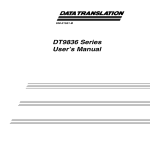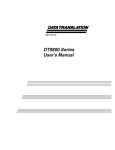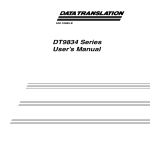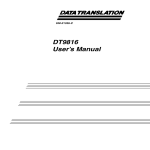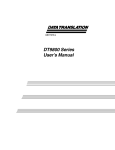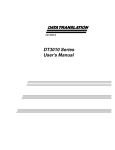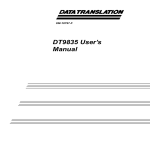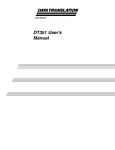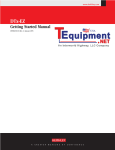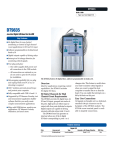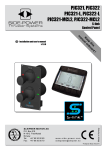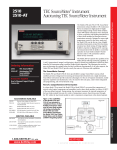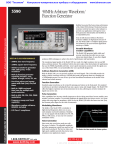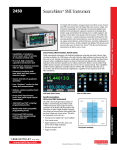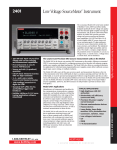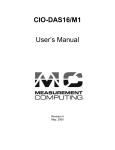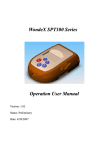Download KUSB-3160 User`s Manual
Transcript
www.keithley.com KUSB-3160 User’s Manual KUSB3160-900-01 Rev. A / January 2005 A G R E A T E R M E A S U R E O F C O N F I D E N C E WARRANTY Keithley Instruments, Inc. warrants this product to be free from defects in material and workmanship for a period of 3 years from date of shipment. Keithley Instruments, Inc. warrants the following items for 90 days from the date of shipment: probes, cables, rechargeable batteries, diskettes, and documentation. During the warranty period, we will, at our option, either repair or replace any product that proves to be defective. To exercise this warranty, write or call your local Keithley representative, or contact Keithley headquarters in Cleveland, Ohio. You will be given prompt assistance and return instructions. Send the product, transportation prepaid, to the indicated service facility. Repairs will be made and the product returned, transportation prepaid. Repaired or replaced products are warranted for the balance of the original warranty period, or at least 90 days. LIMITATION OF WARRANTY This warranty does not apply to defects resulting from product modification without Keithley’s express written consent, or misuse of any product or part. This warranty also does not apply to fuses, software, non-rechargeable batteries, damage from battery leakage, or problems arising from normal wear or failure to follow instructions. THIS WARRANTY IS IN LIEU OF ALL OTHER WARRANTIES, EXPRESSED OR IMPLIED, INCLUDING ANY IMPLIED WARRANTY OF MERCHANTABILITY OR FITNESS FOR A PARTICULAR USE. THE REMEDIES PROVIDED HEREIN ARE BUYER’S SOLE AND EXCLUSIVE REMEDIES. NEITHER KEITHLEY INSTRUMENTS, INC. NOR ANY OF ITS EMPLOYEES SHALL BE LIABLE FOR ANY DIRECT, INDIRECT, SPECIAL, INCIDENTAL OR CONSEQUENTIAL DAMAGES ARISING OUT OF THE USE OF ITS INSTRUMENTS AND SOFTWARE EVEN IF KEITHLEY INSTRUMENTS, INC., HAS BEEN ADVISED IN ADVANCE OF THE POSSIBILITY OF SUCH DAMAGES. SUCH EXCLUDED DAMAGES SHALL INCLUDE, BUT ARE NOT LIMITED TO: COSTS OF REMOVAL AND INSTALLATION, LOSSES SUSTAINED AS THE RESULT OF INJURY TO ANY PERSON, OR DAMAGE TO PROPERTY. A G R E A T E R M E A S U R E O F C O N F I D E N C E Keithley Instruments, Inc. Corporate Headquarters • 28775 Aurora Road • Cleveland, Ohio 44139 440-248-0400 • Fax: 440-248-6168 • 1-888-KEITHLEY (534-8453) • www.keithley.com 12/04 KUSB-3160 User’s Manual ©2005, Keithley Instruments, Inc. All rights reserved. First Printing, January 2005 Cleveland, Ohio, U.S.A. Document Number: KUSB3160-900-01A Rev. A Manual Print History The print history shown below lists the printing dates of all Revisions and Addenda created for this manual. The Revision Level letter increases alphabetically as the manual undergoes subsequent updates. Addenda, which are released between Revisions, contain important change information that the user should incorporate immediately into the manual. Addenda are numbered sequentially. When a new Revision is created, all Addenda associated with the previous Revision of the manual are incorporated into the new Revision of the manual. Each new Revision includes a revised copy of this print history page. Revision A (Document Number KUSB3160-900-01A)...................................................................... January 2005 All Keithley product names are trademarks or registered trademarks of Keithley Instruments, Inc. Other brand and product names are trademarks or registered trademarks of their respective holders. Safety Precautions The following safety precautions should be observed before using this product and any associated instrumentation. Although some instruments and accessories would normally be used with non-hazardous voltages, there are situations where hazardous conditions may be present. This product is intended for use by qualified personnel who recognize shock hazards and are familiar with the safety precautions required to avoid possible injury. Read and follow all installation, operation, and maintenance information carefully before using the product. Refer to the manual for complete product specifications. If the product is used in a manner not specified, the protection provided by the product may be impaired. The types of product users are: Responsible body is the individual or group responsible for the use and maintenance of equipment, for ensuring that the equipment is operated within its specifications and operating limits, and for ensuring that operators are adequately trained. Operators use the product for its intended function. They must be trained in electrical safety procedures and proper use of the instrument. They must be protected from electric shock and contact with hazardous live circuits. Maintenance personnel perform routine procedures on the product to keep it operating properly, for example, setting the line voltage or replacing consumable materials. Maintenance procedures are described in the manual. The procedures explicitly state if the operator may perform them. Otherwise, they should be performed only by service personnel. Service personnel are trained to work on live circuits, and perform safe installations and repairs of products. Only properly trained service personnel may perform installation and service procedures. Keithley products are designed for use with electrical signals that are rated Measurement Category I and Measurement Category II, as described in the International Electrotechnical Commission (IEC) Standard IEC 60664. Most measurement, control, and data I/O signals are Measurement Category I and must not be directly connected to mains voltage or to voltage sources with high transient overvoltages. Measurement Category II connections require protection for high transient over-voltages often associated with local AC mains connections. Assume all measurement, control, and data I/O connections are for connection to Category I sources unless otherwise marked or described in the Manual. Exercise extreme caution when a shock hazard is present. Lethal voltage may be present on cable connector jacks or test fixtures. The American National Standards Institute (ANSI) states that a shock hazard exists when voltage levels greater than 30V RMS, 42.4V peak, or 60VDC are present. A good safety practice is to expect that hazardous voltage is present in any unknown circuit before measuring. Operators of this product must be protected from electric shock at all times. The responsible body must ensure that operators are prevented access and/or insulated from every connection point. In some cases, connections must be exposed to potential human contact. Product operators in these circumstances must be trained to protect themselves from the risk of electric shock. If the circuit is capable of operating at or above 1000 volts, no conductive part of the circuit may be exposed. Do not connect switching cards directly to unlimited power circuits. They are intended to be used with impedance limited sources. NEVER connect switching cards directly to AC mains. When connecting sources to switching cards, install protective devices to limit fault current and voltage to the card. Before operating an instrument, make sure the line cord is connected to a properly grounded power receptacle. Inspect the connecting cables, test leads, and jumpers for possible wear, cracks, or breaks before each use. When installing equipment where access to the main power cord is restricted, such as rack mounting, a separate main input power disconnect device must be provided, in close proximity to the equipment and within easy reach of the operator. For maximum safety, do not touch the product, test cables, or any other instruments while power is applied to the circuit under test. ALWAYS remove power from the entire test system and discharge any capacitors before: connecting or disconnecting cables or jumpers, installing or removing switching cards, or making internal changes, such as installing or removing jumpers. Do not touch any object that could provide a current path to the common side of the circuit under test or power line (earth) ground. Always make measurements with dry hands while standing on a dry, insulated surface capable of withstanding the voltage being measured. The instrument and accessories must be used in accordance with its specifications and operating instructions or the safety of the equipment may be impaired. Do not exceed the maximum signal levels of the instruments and accessories, as defined in the specifications and operating information, and as shown on the instrument or test fixture panels, or switching card. When fuses are used in a product, replace with same type and rating for continued protection against fire hazard. Chassis connections must only be used as shield connections for measuring circuits, NOT as safety earth ground connections. If you are using a test fixture, keep the lid closed while power is applied to the device under test. Safe operation requires the use of a lid interlock. 5/03 If a screw is present, connect it to safety earth ground using the wire recommended in the user documentation. The ! symbol on an instrument indicates that the user should refer to the operating instructions located in the manual. The symbol on an instrument shows that it can source or measure 1000 volts or more, including the combined effect of normal and common mode voltages. Use standard safety precautions to avoid personal contact with these voltages. The frame. symbol indicates a connection terminal to the equipment The WARNING heading in a manual explains dangers that might result in personal injury or death. Always read the associated information very carefully before performing the indicated procedure. The CAUTION heading in a manual explains hazards that could damage the instrument. Such damage may invalidate the warranty. Instrumentation and accessories shall not be connected to humans. Before performing any maintenance, disconnect the line cord and all test cables. To maintain protection from electric shock and fire, replacement components in mains circuits, including the power transformer, test leads, and input jacks, must be purchased from Keithley Instruments. Standard fuses, with applicable national safety approvals, may be used if the rating and type are the same. Other components that are not safety related may be purchased from other suppliers as long as they are equivalent to the original component. (Note that selected parts should be purchased only through Keithley Instruments to maintain accuracy and functionality of the product.) If you are unsure about the applicability of a replacement component, call a Keithley Instruments office for information. To clean an instrument, use a damp cloth or mild, water based cleaner. Clean the exterior of the instrument only. Do not apply cleaner directly to the instrument or allow liquids to enter or spill on the instrument. Products that consist of a circuit board with no case or chassis (e.g., data acquisition board for installation into a computer) should never require cleaning if handled according to instructions. If the board becomes contaminated and operation is affected, the board should be returned to the factory for proper cleaning/servicing. Table of Contents About this Manual . . . . . . . . . . . . . . . . . . . . . . . . . . . . . . . . . . ix Intended Audience. . . . . . . . . . . . . . . . . . . . . . . . . . . . . . . . . . . . . . ix What You Should Learn from this Manual. . . . . . . . . . . . . . . . . . ix Conventions Used in this Manual . . . . . . . . . . . . . . . . . . . . . . . . . . x Related Information . . . . . . . . . . . . . . . . . . . . . . . . . . . . . . . . . . . . . . x Where To Get Help. . . . . . . . . . . . . . . . . . . . . . . . . . . . . . . . . . . . . . xi Chapter 1: Overview . . . . . . . . . . . . . . . . . . . . . . . . . . . . . . . . 1 Key Features . . . . . . . . . . . . . . . . . . . . . . . . . . . . . . . . . . . . . . . . . . . . 2 Supported Software . . . . . . . . . . . . . . . . . . . . . . . . . . . . . . . . . . . . . . 3 Accessories . . . . . . . . . . . . . . . . . . . . . . . . . . . . . . . . . . . . . . . . . . . . . 4 Chapter 2: Principles of Operation . . . . . . . . . . . . . . . . . . . . 5 Digital I/O Lines . . . . . . . . . . . . . . . . . . . . . . . . . . . . . . . . . . . . . . . . 8 Resolution . . . . . . . . . . . . . . . . . . . . . . . . . . . . . . . . . . . . . . . . . . . . . 10 Interrupts . . . . . . . . . . . . . . . . . . . . . . . . . . . . . . . . . . . . . . . . . . . . . . 13 Operation Modes . . . . . . . . . . . . . . . . . . . . . . . . . . . . . . . . . . . . . . . 14 Chapter 3: Supported Device Driver Capabilities. . . . . . . . 15 Chapter 4: Programming Flowcharts. . . . . . . . . . . . . . . . . . 25 Single-Value Operations . . . . . . . . . . . . . . . . . . . . . . . . . . . . . . . . . 27 Continuous Digital Input Operations . . . . . . . . . . . . . . . . . . . . . . 29 Chapter 5: Troubleshooting . . . . . . . . . . . . . . . . . . . . . . . . . 33 General Checklist . . . . . . . . . . . . . . . . . . . . . . . . . . . . . . . . . . . . . . . 34 Service and Support . . . . . . . . . . . . . . . . . . . . . . . . . . . . . . . . . . . . . 37 vii Contents Appendix A: Specifications . . . . . . . . . . . . . . . . . . . . . . . . . 39 Appendix B: Connector Pin Assignments . . . . . . . . . . . . . 43 Index . . . . . . . . . . . . . . . . . . . . . . . . . . . . . . . . . . . . . . . . . . . . . 53 viii About this Manual This manual describes the features of the KUSB-3160 module, the capabilities of the device driver, and how to program the KUSB-3160 module using DT-Open Layers™ software. Troubleshooting information is also provided. Intended Audience This document is intended for engineers, scientists, technicians, or others responsible for using and/or programming the KUSB-3160 module for data acquisition operations in the Microsoft® Windows 2000 or Windows XP operating systems. It is assumed that you have some familiarity with data acquisition principles and that you understand your application. What You Should Learn from this Manual This manual provides detailed information about the features of the KUSB-3160 module and the capabilities of the device driver. It is organized as follows: • Chapter 1, “Overview,” describes the major features of the modules, as well as the supported software and accessories for the modules. • Chapter 2, “Principles of Operation,” describes all of the features of the modules and how to use them in your application. • Chapter 3, “Supported Device Driver Capabilities,” lists the data acquisition subsystems and the associated features accessible using the device driver. • Chapter 4, “Programming Flowcharts,” describes the processes you must follow to program the subsystems on the KUSB-3160 module using DT-Open Layers-compliant software. ix About this Manual • Chapter 5, “Troubleshooting,” provides information that you can use to resolve problems with the modules and the device driver, should they occur. • Appendix A, “Specifications,” lists the specifications of the module. • Appendix B, “Connector Pin Assignments,” shows the pin assignments for the connectors and the screw terminal assignments for the module. • An index completes this manual. Conventions Used in this Manual The following conventions are used in this manual: • Notes provide useful information or information that requires special emphasis, cautions provide information to help you avoid losing data or damaging your equipment, and warnings provide information to help you avoid catastrophic damage to yourself or your equipment. • Items that you select or type are shown in bold. Related Information Refer to the following documents for more information on using the KUSB-3160 module: • KUSB-3160 Getting Started Manual. This manual describes the how to install the KUSB-3160 module and related software. • DataAcq SDK User’s Manual. For programmers who are developing their own application programs using the Microsoft C compiler, this manual describes how to use the DT-Open LayersTM DataAcq SDKTM in Windows 2000 or Windows XP to access the capabilities of your module. x About this Manual • DTx-EZ Getting Started Manual. This manual describes how to use the ActiveX controls provided in DTx-EZTM to access the capabilities of your module in Microsoft Visual Basic® or Visual C++®. • DT-LV Link Getting Started Manual. This manual describes how to use DT-LV LinkTM with the LabVIEW® graphical programming language to access the capabilities of your module. • Microsoft Windows 2000 or Windows XP documentation. • USB web site (http://www.usb.org). Where To Get Help Should you run into problems installing or using your KUSB-3160 module, please call the Keithley Technical Support Department. xi About this Manual xii 1 Overview Key Features . . . . . . . . . . . . . . . . . . . . . . . . . . . . . . . . . . . . . . . . . . . . 2 Supported Software . . . . . . . . . . . . . . . . . . . . . . . . . . . . . . . . . . . . . . 3 Accessories . . . . . . . . . . . . . . . . . . . . . . . . . . . . . . . . . . . . . . . . . . . . . 4 1 Chapter 1 Key Features The KUSB-3160 is a low-cost, high-power, digital I/O module for the Universal Serial Bus (USB). The KUSB-3160 module provides the following major features: • USB compatibility; • 64 configurable digital I/O lines (configurable in banks of eight) and 32 dedicated digital input lines for nonclocked monitoring or control. • Interrupt-on-change on 16 dedicated digital input lines. • External solid-state relay module support. Digital outputs can drive sink 12 mA, source 100 kΩ pullup. • Isolated output common from the USB bus to 500 V peak. 2 Overview Supported Software The following software is available for use with the KUSB-3160 module: • Device Driver −This software is provided on the CD shipped with the module. The device driver allows you to use a KUSB-3160 module with any of the supported software packages or utilities. Refer to the KUSB-3160 Getting Started Manual for more information on loading and configuring the device driver. • Quick Data Acq application −This application provides a quick way to get a KUSB-3160 module up and running. Using the Quick Data Acq application, you can verify the features of the module, display data on the screen, and save data to disk. • DataAcq SDK −This DT-Open Layers Software Develop Kit (SDK) allows programmers to develop application programs for the KUSB-3160 using the Microsoft C compiler in Windows 2000 or Windows XP. • DTx-EZ −This software package contains ActiveX controls that allow Microsoft Visual Basic® or Visual C++® programmers to access the capabilities of the KUSB-3160 module. • DT-LV Link −This software package allows LabVIEW® programmers to access the capabilities of the KUSB-3160 module. 1 1 1 1 1 1 1 1 1 3 Chapter 1 Accessories The following accessories are provided for the KUSB-3160 module: • KUSB-STP100 −a 100 mm x 160 mm screw terminal panel that connects to the KUSB-3160 module using the KUSB-CABDIO cable. This screw terminal panel allows you to connect all of the input and output connections that are supported by a KUSB-3160 module. LEDs on up to 64 of the outputs light when the outputs are low. Note that the LEDs are not provided for the dedicated digital input lines. • KUSB-CABDIO −a 1-meter, 100-conductor cable that connects the KUSB-STP100 screw terminal panel to the KUSB-3160 module. 4 2 Principles of Operation Digital I/O Lines . . . . . . . . . . . . . . . . . . . . . . . . . . . . . . . . . . . . . . . . 8 Resolution . . . . . . . . . . . . . . . . . . . . . . . . . . . . . . . . . . . . . . . . . . . . . 10 Interrupts . . . . . . . . . . . . . . . . . . . . . . . . . . . . . . . . . . . . . . . . . . . . . . 13 Operation Modes . . . . . . . . . . . . . . . . . . . . . . . . . . . . . . . . . . . . . . . 14 5 Chapter 2 Figure 1 shows a block diagram of the KUSB-3160 module. Note that bold entries indicate signals you can access. Pins 1 to 64 Lines 0 to 63 Pins 50 and 100 64 Digital I/O WIth 100 kΩ Pull-Ups to +5V_I WIth Back EMF Protection Pins 49 and 99 Isolated Common +5 V In/Out Pins 64 to 96 Lines 63 to 95 Controller and Digital Filters 32 Digital Inputs WIth 100 kΩ Pull-Ups to +5V_I WIth Back EMF Protection High-Speed Isolated Data Path Isolated Power 500 V Isolation Barrier Power Control DC to DC Microcontroller USB Interface +5 V D + D - GND Figure 1: Block Diagram of the KUSB-3160 Module 6 Principles of Operation This chapter describes the following features of the digital I/O subsystem: • Digital I/O lines, described on page 8; 2 • Resolution, described on page 10; • Interrupts, described on page 13, and 2 • Operation modes, described on page 14. 2 2 2 2 2 2 2 7 Chapter 2 Digital I/O Lines The KUSB-3160 module supports 64 shared digital I/O lines. These lines are organized as eight digital banks (banks 0 to 7)), each containing eight digital I/O lines (lines 0 to 7). The KUSB-3160 module also supports 32 dedicated digital input lines. These lines are organized as four banks (banks 8 to 11), each containing eight digital input lines (lines 0 to 7). You access the digital inputs through the digital input (DIN) subsystem and the digital outputs through the digital output (DOUT) subsystem. The inputs are pulled up to +5 V through a 100 kΩ resistor. You can choose to debounce the inputs using the Open Layers Control Panel. When debounce is selected, a debounce delay of 5 ms occurs before a change is passed through the digital filter on the module. When debounce is not selected (the default configuration), a delay of less than 1 ms occurs. Refer to the KUSB-3160 Getting Started Manual for more information. Outputs are open collectors with a 100 kΩ resistor connected to the internal isolated +5 V. All outputs are diode-protected for back EMF voltages typically seen when driving relays. The output stage latches are normally powered by the module. However, you can externally power the +5 V output so that the digital outputs retain their current values when the module is powered down. Note: +5 V output is available only when one of the subsystems is activated, which, in turn, activates power to the module. The KUSB-3160 provides enough current to drive only one LED per output line on the KUSB-STP100 screw terminal panel at a time. An LED turns on when the output is low. 8 Principles of Operation You can specify the digital input lines to read in a single-value digital I/O or continuous operation. You can specify the digital output lines to write to in a single-value digital I/O operation. Refer to page 14 for more information on digital I/O operation modes. Note: Continuous digital input operations are supported by digital input banks 10 and 11 only. Therefore, in continuous mode, the resolution is always 16 bits. 2 2 2 The number of digital I/O lines that are read or written to depend on the resolution that is specified, as described in the next section. 2 2 2 2 2 2 9 Chapter 2 Resolution Using software, specify the number of digital I/O lines to read or write at once by specifying the resolution as 8, 16, 24, or 32. Table 1 shows the effect of resolution on the number of DIN and DOUT subsystems available for a bank. Note: If you are using digital input banks 10 and 11 in continuous mode, the resolution is always 16 bits. Table 1: Resolution, Digital I/O Lines, and Number of Subsystems Resolution 8 10 Digital I/O Lines DIN or DOUT Subsystem Bank 0, lines 0 to 7 Element 0 Bank 1, lines 0 to 7 Element 1 Bank 2, lines 0 to 7 Element 2 Bank 3, lines 0 to 7 Element 3 Bank 4, lines 0 to 7 Element 4 Bank 5, lines 0 to 7 Element 5 Bank 6, lines 0 to 7 Element 6 Bank 7, lines 0 to 7 Element 7 a Bank 8, lines 0 to 7 Element 8 Bank 9, lines 0 to 7a Element 9 Bank 10, lines 0 to 7a Element 10 Bank 11, lines 0 to 7a Element 11 Principles of Operation Table 1: Resolution, Digital I/O Lines, and Number of Subsystems (cont.) Resolution Digital I/O Lines 16 Banks 0 and 1, lines 0 and 15 combined Element 0 Banks 2 and 3, lines 0 and 15 combined Element 2 Banks 4 and 5, lines 0 and 15 combined Element 4 Banks 6 and 7, lines 0 and 15 combined Element 6 Banks 8 and 9, lines 0 and 15 combineda Element 8 Banks 10 and 11, lines 0 and 15 combineda Element 10 Banks 0, 1, and 2, lines 0 to 23 combined Element 0 Banks 3, 4, and 5, lines 0 to 23 combined Element 3 Banks 6, 7, and 8, lines 0 to 23 combineda Element 6 Banks 9, 10, and 11, lines 0 to 23 combineda Element 9 Banks 0, 1, 2, and 3, lines 0 to 31 Element 0 Banks 4, 5, 6, and 7, lines 0 to 31 Element 4 Banks 8, 9, 10, and 11, lines 0 to 31a Element 8 24 32 2 DIN or DOUT Subsystem a. Banks 8 to 11 are dedicated digital input lines. All other banks can be used as digital input or digital output lines. 2 2 2 2 2 2 2 2 11 Chapter 2 For example, if you specify a resolution of 8, you can read or write to each digital bank separately by specifying element number 0 to 11. If you specify a resolution of 16, you can read or write to two banks at once by specifying element 0, 2, 4, 6, 8, or 10. If you specify a resolution of 24, you can read or write to three banks at once by specifying element 0, 3, 6, or 9. Lastly, if you specify a resolution of 32, you can read or write to four banks at once by specifying element 0, 4, or 8. The data is encoded in binary format. 12 Principles of Operation Interrupts The KUSB-3160 module can generate a PCI-bus interrupt when any of the digital input lines corresponding to banks 10 and 11 changes state. This feature is useful when you want to monitor critical signals or when you want to signal the host computer to transfer data to or from the module. You enable the interrupts on a bit-by-bit basis using the Open Layers Control Panel. Refer to the KUSB-3160 Getting Started Manual for more information. Use software to determine which digital input line changed state. 2 2 2 2 2 2 2 2 2 13 Chapter 2 Operation Modes KUSB-3160 modules support the following digital I/O operation modes: • Single-value operations are the simplest to use but do not allow you to check the interrupt status. Use software to specify the DIN or DOUT subsystem, the resolution, and a gain of 1 (the gain is ignored). Data is then read from or written to the appropriate digital I/O lines. Single-value operations stop automatically when finished; you cannot stop a single-value operation. • Continuous digital input allows you to read digital input values as well as check the interrupt status of the digital input lines corresponding to banks 10 and 11. Use software to specify the DIN subsystem element, continuous mode, the resolution, the trigger source as software, and the window or procedure to handle the messages. Once the operation is configured and started, an event done message is generated when the interrupt occurs. You can then read the value and determine which digital I/O line changed state to cause the interrupt. 14 4 Programming Flowcharts Single-Value Operations . . . . . . . . . . . . . . . . . . . . . . . . . . . . . . . . . 27 Continuous Digital Input Operations . . . . . . . . . . . . . . . . . . . . . . 29 25 Chapter 4 The following flowcharts show the steps required to perform data acquisition operations using DT-Open Layers. For illustration purposes, the DataAcq SDK functions are shown; however, the concepts apply to all DT-Open Layers software. Note that many steps represent several substeps; if you are unfamiliar with the detailed operations involved with any one step, refer to the indicated page for detailed information. Optional steps appear in shaded boxes. 26 Programming Flowcharts Single-Value Operations . Initialize the device driver and get the device handle with olDaInitialize. Get a handle to the subsystem with olDaGetDASS. 4 Specify DIN for a digital input subsystem or DOUT for a digital output subsystem. Set the data flow to OL_DF_SINGLEVALUE using olDaSetDataFlow. Set the resolution with olDaSetResolution. Configure the subsystem using olDaConfig. Go to the next page. 4 4 4 Set the resolution to 8, 16, 24, or 32. See page 10 for more information. 4 4 4 4 4 27 Chapter 4 Continued from previous page. Acquiring data? Yes Acquire a single value using olDaGetSingleValue. No Output a single value using olDaPutSingleValue. Acquire/ output another value? Yes No Release the subsystem using olDaReleaseDASS. Release the driver and terminate the session using olDaTerminate. 28 Programming Flowcharts Continuous Digital Input Operations Initialize the device driver and get the device handle with olDaInitialize. 4 Get a handle to the DIN subsystem with olDaGetDASS. Only banks 10 and 11 support continuous digital input operations. Set the data flow to OL_DF_CONTINUOUS using olDaSetDataFlow. 4 4 Set the resolution with olDaSetResolution. Set the resolution to 16. 4 Set the trigger source to OL_TRG_SOFT using olDaSetTrigger. Using main window to handle messages? 4 4 Yes olDaSetWndHandle Specify the window in which to post messages. 4 No olDaSetNotificationProcedure Specify the procedure to handle Windows messages. 4 Go to the next page. 4 29 Chapter 4 Continued from previous page. Configure the subsystem using olDaConfig. Start the operation with olDaStart. Get event done message? No The event done message is OLDA_WM_EVENT_DONE. In olDaSetWndHandle or olDaSetNotificationProcedure, the subsystem handle, HDASS, is returned in the wParam parameter; this allows one window to handle messages from both subsystems. The subsystem status is returned in the IParam parameter. Table 3: Subsystem Status in IParam Bits Yes Definition High Word State of the subsystem. The resolution reflects the number of significant bits and represents actual line states read from the board. Low Word DIO lines (bits) which caused the event. Bit 0 corresponds to subsystem’s bit 0. Bit 1 corresponds to subsystem’s bit 1, and so on. Resolution reflects the # of significant bits. Process data. Stop the operation (see page 31). Clean up the operation (see page 32). 30 Programming Flowcharts Stop the Operation 4 Stop in an orderly way? Yes olDaStop olDaStop stops the operation on the subsystem in an orderly way. 4 No 4 Yes Reinitialize? No olDaReset olDaAbort and olDaReset stop the operation on the subsystem immediately. olDaReset also reinitializes the subsystem to a known state. 4 olDaAbort 4 4 4 4 4 31 Chapter 4 Clean up the Operation olDaReleaseDASS olDaTerminate 32 Release each subsystem. Release the device driver and terminate the session. 3 Supported Device Driver Capabilities 15 Chapter 3 The KUSB-3160 Device Driver provides support for DIN and DOUT subsystems. For information on how to configure the device driver, refer to the KUSB-3160 Getting Started Manual. Table 2 summarizes the features available for use with the DataAcq SDK and the KUSB-3160 modules. The DataAcq SDK provides functions that return support information for specified subsystem capabilities at run-time. The first row in the table lists the subsystem types. The first column in the table lists all possible subsystem capabilities. A description of each capability is followed by the parameter used to describe that capability in the DataAcq SDK. Note: Blank fields represent unsupported options. The DataAcq SDK uses the functions olDaGetSSCaps (for those queries starting with OLSSC) and olDaGetSSCapsEx (for those queries starting with OLSSCE) to return the supported subsystem capabilities for a device. For more information, refer to the description of these functions in the DataAcq SDK online help. See the DataAcq Getting Started Manual for information on launching this help file. 16 Supported Device Driver Capabilities Table 2: KUSB-3160 Supported Options KUSB-3160 Data Flow Mode Total Subsystems on Board A/D 0 D/A 0 DIN 12 Single-Value Operation Support OLSSC_SUP_SINGLEVALUE Yes Continuous Operation Support OLSSC_SUP_CONTINUOUS Yesb Continuous Operation until Trigger Event Support OLSSC_SUP_CONTINUOUS_PRETRIG a DOUT SRL a 8 Yes 0 C/T 3 0 3 3 Continuous Operation before and after Trigger Event OLSSC_SUP_CONTINUOUS_ ABOUTTRIG 3 DT-Connect Support OLSSC_SUP_DTCONNECT Continuous DT-Connect Support OLSSC_SUP_DTCONNECT_ CONTINUOUS 3 Wind. Pause Sim. Mess. Oper. Oper. Burst DT-Connect Support OLSSC_SUP_DTCONNECT_BURST 3 Simultaneous Start List Support OLSSC_SUP_SIMULTANEOUS_START Pause Operation Support OLSSC_SUP_PAUSE Asynchronous Operation Support OLSSC_SUP_POSTMESSAGE Yes 3 Buffering Buffer Support OLSSC_SUP_BUFFERING Single Buffer Wrap Mode Support OLSSC_SUP_WRPSINGLE 3 Multiple Buffer Wrap Mode Support OLSSC_SUP_WRPMULTIPLE Inprocess Buffer Flush Support OLSSC_SUP_INPROCESSFLUSH 3 17 Chapter 3 Table 2: KUSB-3160 Supported Options (cont.) KUSB-3160 A/D D/A DIN Total Subsystems on Board 0 0 12a DMA Number of DMA Channels OLSSC_NUMDMACHANS DOUT SRL 8a 0 0 0 0 Maximum Retrigger Frequency OLSSCE_MAXRETRIGGER 0 0 Minimum Retrigger Frequency OLSSCE_MINRETRIGGER 0 0 Maximum Channel Gain-List Depth OLSSC_CGL_DEPTH 0 0 Supports Gap Free Data with No DMA OLSSC_SUP_GAPFREE_NODMA Supports Gap Free Data with Single DMA OLSSC_SUP_GAPFREE_SINGLEDMA Supports Gap Free Data with Dual DMA OLSSC_SUP_GAPFREE_DUALDMA Triggered Scan Support OLSSC_SUP_TRIGSCAN Channel-Gain List Triggered Scan Mode Maximum Number of CGL Scans per Trigger OLSSC_MAXMULTISCAN 18 Supports Scan per Trigger Event Triggered Scan OLSSC_SUP_RETRIGGER_SCAN_ PER_TRIGGER Supports Internal Retriggered Triggered Scan OLSSC_SUP_RETRIGGER_INTERNAL Extra Retrigger Support OLSSC_SUP_RETRIGGER_EXTRA Sequential Channel Gain-List Support OLSSC_SUP_SEQUENTIAL_CGL Zero Start Sequential Channel-Gain List Support OLSSC_SUP_ZEROSEQUENTIAL_CGL 0 C/T 0 Supported Device Driver Capabilities Table 2: KUSB-3160 Supported Options (cont.) KUSB-3160 Channel-Gain List (cont.) Total Subsystems on Board A/D 0 D/A DIN 0 12 DOUT SRL a a 8 Simultaneous Sample and Hold Support OLSSC_SUP_SIMULTANEOUS_SH 0 C/T 3 0 3 Random Channel-Gain List Support OLSSC_SUP_RANDOM_CGL Channel List Inhibit Support OLSSC_SUP_CHANNELLIST_ INHIBIT 3 Gain Programmable Gain Support OLSSC_SUP_PROGRAMGAIN Number of Gains OLSSC_NUMGAINS 1 1 3 AutoRanging Support I/O Channels Synchronous Digital I/O OLSSC_SINGLEVALUE_AUTORANGE 3 Synchronous Digital I/O Support OLSSC_SUP_SYNCHRONOUS_ DIGITALIO Maximum Synchronous Digital I/O Value OLSSC_MAX_DIGITALIOLIST_VALUE 0 0 Number of Channels OLSSC_NUMCHANNELS 1 1 3 SE Support OLSSC_SUP_SINGLEENDED Channel Type 3 SE Channels OLSSC_MAXSECHANS 0 0 DI Support OLSSC_SUP_DIFFERENTIAL Yes Yes DI Channels OLSSC_MAXDICHANS 1 1 3 3 19 Chapter 3 Data Encoding Resolution Ranges Filters Table 2: KUSB-3160 Supported Options (cont.) KUSB-3160 A/D D/A DIN Total Subsystems on Board 0 0 12a DOUT SRL 8a Filter/Channel Support OLSSC_SUP_FILTERPERCHAN Number of Filters OLSSC_NUMFILTERS 1 1 Number of Voltage Ranges OLSSC_NUMRANGES 0 0 Software Programmable Resolution OLSSC_SUP_SWRESOLUTION Yes Yes Number of Resolutions OLSSC_NUMRESOLUTIONS 4c 4c Binary Encoding Support OLSSC_SUP_BINARY Yes Yes Range per Channel Support OLSSC_SUP_RANGEPERCHANNEL Twos Complement Support OLSSC_SUP_2SCOMP Software Trigger Support OLSSC_SUP_SOFTTRIG Yes External Trigger Support OLSSC_SUP_EXTERNTRIG Triggers Positive Threshold Trigger Support OLSSC_SUP_THRESHTRIGPOS Negative Threshold Trigger Support OLSSC_SUP_THRESHTRIGNEG Analog Event Trigger Support OLSSC_SUP_ANALOGEVENTTRIG Digital Event Trigger Support OLSSC_SUP_DIGITALEVENTTRIG Timer Event Trigger Support OLSSC_SUP_TIMEREVENTTRIG Number of Extra Triggers OLSSC_NUMEXTRATRIGGERS 20 0 0 0 C/T 0 Supported Device Driver Capabilities Table 2: KUSB-3160 Supported Options (cont.) KUSB-3160 Total Subsystems on Board A/D 0 D/A DIN 0 12 DOUT SRL a a 8 Internal Clock Support OLSSC_SUP_INTCLOCK Clocks (cont.) Number of Extra Clocks OLSSC_NUMEXTRACLOCKS 0 0 Base Clock Frequency OLSSCE_BASECLOCK 0 0 Maximum External Clock Divider OLSSCE_MAXCLOCKDIVIDER 1 1 Minimum External Clock Divider OLSSCE_MINCLOCKDIVIDER 1 1 Maximum Throughput OLSSCE_MAX_THROUGHPUT 0 0 Minimum Throughput OLSSCE_MIN_THROUGHPUT 0 0 Event Count Mode Support OLSSC_SUP_CTMODE_COUNT Counter/Timers Generate Rate Mode Support OLSSC_SUP_CTMODE_RATE One-Shot Mode Support OLSSC_SUP_CTMODE_ONESHOT Repeatable One-Shot Mode Support OLSSC_SUP_CTMODE_ONESHOT_ RPT Up/Down Counting Mode Support 3 0 3 External Clock Support OLSSC_SUP_EXTCLOCK Cascading Support OLSSC_SUP_CASCADING 0 C/T 3 3 3 3 3 3 OLSSC_SUP_CTMODE_UP_DOWN Edge-to-Edge Measurement Mode Support OLSSC_SUP_CTMODE_MEASURE 3 21 Chapter 3 Table 2: KUSB-3160 Supported Options (cont.) KUSB-3160 A/D D/A DIN Total Subsystems on Board 0 0 12a High to Low Output Pulse Support OLSSC_SUP_PLS_HIGH2LOW Low to High Output Pulse Support OLSSC_SUP_PLS_LOW2HIGH None (internal) Gate Type Support OLSSC_SUP_GATE_NONE High Level Gate Type Support OLSSC_SUP_GATE_HIGH_LEVEL Low Level Gate Type Support OLSSC_SUP_GATE_LOW_LEVEL Counter/Timers (cont.) High Edge Gate Type Support OLSSC_SUP_GATE_HIGH_EDGE Low Edge Gate Type Support OLSSC_SUP_GATE_LOW_EDGE Level Change Gate Type Support OLSSC_SUP_GATE_LEVEL High Level Gate Type with Input Debounce Support OLSSC_SUP_GATE_HIGH_LEVEL_ DEBOUNCE Low Level Gate Type with Input Debounce Support OLSSC_SUP_GATE_LOW_LEVEL_ DEBOUNCE High Edge Gate Type with Input Debounce Support OLSSC_SUP_GATE_HIGH_EDGE_ DEBOUNCE Low Edge Gate Type with Input Debounce Support OLSSC_SUP_GATE_LOW_EDGE_ DEBOUNCE 22 DOUT SRL 8a 0 C/T 0 Supported Device Driver Capabilities Table 2: KUSB-3160 Supported Options (cont.) KUSB-3160 FIFOs Counter/ Interrupt Timers (cont.) Total Subsystems on Board A/D 0 D/A DIN 0 12a DOUT SRL a 8 C/T 0 Yesd 3 FIFO in Data Path Support OLSSC_SUP_FIFO Output FIFO Size OLSSC_FIFO_SIZE_IN_K Software Calibration Processor 0 3 Level Change Gate Type with Input Debounce Support OLSSC_SUP_GATE_LEVEL_ DEBOUNCE Interrupt Support OLSSC_SUP_INTERRUPT 3 Data Processing Capability OLSSC_SUP_PROCESSOR 3 3 Software Calibration Support OLSSC_SUP_SWCAL a. A total of eight banks of eight digital I/O lines and four banks of eight dedicated digital input lines exist on the board. You can configure the nondedicated banks for either digital input or digital output when you configure the device driver. Refer to the KUSB-3160 Getting Started Manual for more information on configuring the device driver. b. Continuous digital input operations are supported by digital input banks 10 and 11 only. c. The number of subsystem elements depends on the bank size or resolution established in the driver configuration dialog. Values for resolution are 8, 16, 24, or 32. If you are using digital input banks 10 and 11 in continuous mode, the resolution is always 16 bits. Refer to page 10 for more information on resolution. d. Digital banks 10 and 11 can generate an interrupt on a bit-by-bit basis. You configure the digital lines to interrupt using the Open Layers Control Panel. Refer to the KUSB-3160 Getting Started Manual for more information. 3 3 3 3 23 Chapter 3 24 5 Troubleshooting General Checklist . . . . . . . . . . . . . . . . . . . . . . . . . . . . . . . . . . . . . . . 34 Service and Support . . . . . . . . . . . . . . . . . . . . . . . . . . . . . . . . . . . . . 37 33 Chapter 5 General Checklist Should you experience problems using the KUSB-3160 module, please follow these steps: 1. Read all the documentation provided for your product. Make sure that you have added any “Read This First” information to your manual and that you have used this information. 2. Check the Keithley CD for any README files and ensure that you have used the latest installation and configuration information available. 3. Check that your system meets the requirements stated in the KUSB-3160 Getting Started Manual. 4. Check that you have installed your hardware properly using the instructions in the KUSB-3160 Getting Started Manual. 5. Check that you have installed and configured the device driver properly using the instructions in the KUSB-3160Getting Started Manual. If you still experience problems, try using the information in Table 4 to isolate and solve the problem. If you cannot identify the problem, refer to page 37. 34 Troubleshooting Table 4: Troubleshooting Problems Symptom Module does not respond. Intermittent operation. Device failure error reported. Possible Cause Possible Solution The module configuration is incorrect. Check the configuration of your device driver; see the instructions in the KUSB-3160 Getting Started Manual. The module is damaged. Contact Keithley for technical support; refer to page 37. Loose connections or vibrations exist. Check your wiring and tighten any loose connections or cushion vibration sources; see the instructions in the KUSB-3160 Getting Started Manual. The module is overheating. Check environmental and ambient temperature; consult the module’s specifications on page 41 of this manual and the documentation provided by your computer manufacturer for more information. Electrical noise exists. Check your wiring and either provide better shielding or reroute unshielded wiring; see the instructions in the KUSB-3160 Getting Started Manual. The KUSB-3160 module cannot communicate with the Microsoft bus driver or a problem with the bus driver exists. Check your cabling and wiring and tighten any loose connections; see the instructions in the KUSB-3160 Getting Started Manual. The KUSB-3160 module was removed while an operation was being performed. Ensure that your KUSB-3160 module is properly connected; see the instructions in the KUSB-3160 Getting Started Manual. 5 5 5 5 5 5 5 5 5 35 Chapter 5 Table 4: Troubleshooting Problems (cont.) Symptom Data appears to be invalid. Computer does not boot. 36 Possible Cause Possible Solution An open connection exists. Check your wiring and fix any open connections; see the instructions in the KUSB-3160 Getting Started Manual. A signal source is not connected to the channel being read. Check the transducer connections; see the instructions in the KUSB-3160 Getting Started Manual. The power supply of the computer is too small to handle all the system resources. Check the power requirements of your system resources and, if needed, get a larger power supply; consult the module’s specifications on page 41 of this manual. Troubleshooting Service and Support For the latest tips, software fixes, and other product information, you can always access our World-Wide Web site at the following address: http://www.keithley.com If you have difficulty using a KUSB-3160 module, the Keithley Technical Support Department is available to provide technical assistance. For the most efficient service, complete the form on page 38 and be at your computer when you call for technical support. This information helps to identify specific system and configuration-related problems and to replicate the problem in house, if necessary. 5 5 5 5 5 5 5 5 5 37 Chapter 5 Information Required for Technical Support Name:___________________________________________Phone__________________________ Contract Number: __________________________________________________________________ Address: _________________________________________________________________________ ________________________________________________________________________________ Hardware product(s): _______________________________________________________________ serial number: _________________________________________________________________ configuration: _________________________________________________________________ Device driver: ____________________________________ ________________________________ _______________________________________________ version: _________________________ Software: ________________________________________ ________________________________ serial number: ________________________________ version:__________________________ PC make/model: ___________________________________________________________________ operating system: _____________________________ version:__________________________ Windows version: ______________________________________________________________ processor: ___________________________________ speed:___________________________ RAM: _______________________________________ hard disk space:____________________ network/number of users: _______________________ disk cache:________________________ graphics adapter: _____________________________ data bus:_________________________ I have the following modules and applications installed in my system:___________________________ ________________________________________________________________________________ ________________________________________________________________________________ I am encountering the following problem(s): ______________________________________________ ________________________________________________________________________________ ________________________________________________________________________________ ________________________________________________________________________________ and have received the following error messages/codes: ____________________________________ ________________________________________________________________________________ ________________________________________________________________________________ I have run the module diagnostics with the following results: _________________________________ ________________________________________________________________________________ You can reproduce the problem by performing these steps: 1. _______________________________________________________________________________ ________________________________________________________________________________ 2. _______________________________________________________________________________ ________________________________________________________________________________ 3. _______________________________________________________________________________ ________________________________________________________________________________ 38 A Specifications 39 Appendix A Table 5 lists the specifications for the digital input subsystem. Table 5: DIN Subsystem Specifications Feature Specifications Number of lines 64 shared digital I/O lines and 32 dedicated digital input linesa Termination 100 kΩ Pullup to +5V_Ib Inputs Input type: Input load: High-level input voltage: Low-level input voltage: High-level input current: Low-level input current: Level sensitive 1 (HCT) 2.0 V minimum 0.8 V maximum 100 kΩ Pullup to +5V_Ib −100 µA Back EMF diodes Yes a. The KUSB-3160 module can generate a PCI-bus interrupt when any of the digital input lines corresponding to banks 10 and 11 changes state. b. You can drive the +5V_I isolated output pin from an external power supply. This will allow the last digital output value to be latched to the input stage; therefore, if the power is reduced by the host, the digital output values will not change. Current requirements are 50 mA plus load. Table 6 lists the specifications for the digital output subsystem. Table 6: DOUT Subsystem Specifications Feature 40 Specifications Number of lines 64 shared digital I/O lines Termination 22 Ω series resistor Output driver Open collector (5 V) Specifications Table 6: DOUT Subsystem Specifications (cont.) Feature Specifications Output driver high voltage 100 kΩ Pullup to +5V_Ia Output driver low voltage 0.6 V maximum (IOL = 12 mA) Back EMF diodes Yes a. You can drive the +5V_I isolated output pin from an external power supply. This will allow the last digital output value to be latched to the input stage; therefore, if the power is reduced by the host, the digital output values will not change. Current requirements are 50 mA plus load. Table 7 lists the power, physical, and environmental specifications for the KUSB-3160 module. A A A A Table 7: Power, Physical, and Environmental Specifications Feature Power +5 V Standby: +5 V Enumeration: +5 V Power ON: +5 V Isolated Power Out: Physical Dimensions: Weight: Environmental Operating temperature range: Storage temperature range: Relative humidity: Specifications 500 µA maximum 100 mA maximum 500 mA maximuma 2.5 mA maximum 6.6 inches x 4.5 inches x 1.4 inches 160 mm x 100 mm mounting 16 ounces (448 grams) 0° C to 55° C −25° C to 85° C To 95%, noncondensing a. Typical power supply current is 200 mA on startup. A A A A A 41 Appendix A Table 8 lists the cable and connector specifications for the KUSB-3160 module. Table 8: KUSB-3160 Cable and Connector Specifications Feature Specifications USB cable 2-meter, Type A-B, USB cable AMP part# 974327-1 J1 Connector 100-pin D, Robinson Nugent a part# P50E-100P1-SR1-TG J1 Mating Connector 100-pin D, Robinson Nugent part# P50E-100S-TG a. Because of different vendor number pinning schemes, the Robinson Nugent connector has a mirror pinout from that described in Appendix B. The KUSB-STP100 and KUSB-CABDIO cable already account for the mirroring; however, if you are building your own cable or screw terminal panel, you must take this into account. 42 B Connector Pin Assignments 43 Appendix B Table 9 lists the pin assignments of connector J1 on the KUSB-3160 module and on the KUSB-STP100 screw terminal panel. Note: Because of different vendor number pinning schemes, the Robinson Nugent connector specified on page 42 has a mirror pinout from that described in this appendix. The KUSB-STP100 and KUSB-CABDIO cable already account for the mirroring; however, if you are building your own cable or screw terminal panel, you must take this into account. Table 9: Pin Assignments for Connector J1 Pin Number 44 Signal Description Pin Number Signal Description 1 Bank 0, Bit 0 2 Bank 0, Bit 1 3 Bank 0, Bit 2 4 Bank 0, Bit 3 5 Bank 0, Bit 4 6 Bank 0, Bit 5 7 Bank 0, Bit 6 8 Bank 0, Bit 7 9 Bank 1, Bit 0 10 Bank 1, Bit 1 11 Bank 1, Bit 2 12 Bank 1, Bit 3 13 Bank 1, Bit 4 14 Bank 1, Bit 5 15 Bank 1, Bit 6 16 Bank 1, Bit 7 17 Bank 2, Bit 0 18 Bank 2, Bit 1 19 Bank 2, Bit 2 20 Bank 2, Bit 3 21 Bank 2, Bit 4 22 Bank 2, Bit 5 23 Bank 2, Bit 6 24 Bank 2, Bit 7 25 Bank 3, Bit 0 26 Bank 3, Bit 1 Connector Pin Assignments Table 9: Pin Assignments for Connector J1 (cont.) Pin Number Signal Description Pin Number B Signal Description 27 Bank 3, Bit 2 28 Bank 3, Bit 3 29 Bank 3, Bit 4 30 Bank 3, Bit 5 31 Bank 3, Bit 6 32 Bank 3, Bit 7 33 Bank 4, Bit 0 34 Bank 4, Bit 1 35 Bank 4, Bit 2 36 Bank 4, Bit 3 37 Bank 4, Bit 4 38 Bank 4, Bit 5 39 Bank 4, Bit 6 40 Bank 4, Bit 7 41 Bank 5, Bit 0 42 Bank 5, Bit 1 43 Bank 5, Bit 2 44 Bank 5, Bit 3 45 Bank 5, Bit 4 46 Bank 5, Bit 5 47 Bank 5, Bit 6 48 Bank 5, Bit 7 49 Isolated +5 V 50 Isolated Ground 51 Bank 6, Bit 0 52 Bank 6, Bit 1 53 Bank 6, Bit 2 54 Bank 6, Bit 3 55 Bank 6, Bit 4 56 Bank 6, Bit 5 57 Bank 6, Bit 6 58 Bank 6, Bit 7 59 Bank 7, Bit 0 60 Bank 7, Bit 1 61 Bank 7, Bit 2 62 Bank 7, Bit 3 63 Bank 7, Bit 4 64 Bank 7, Bit 5 65 Bank 7, Bit 6 66 Bank 7, Bit 7 67 Bank 8, Bit 0a 68 Bank 8, Bit 1a 69 Bank 8, Bit 2a 70 Bank 8, Bit 3a B B B B B B B B 45 Appendix B Table 9: Pin Assignments for Connector J1 (cont.) Pin Number Signal Description Pin Number Signal Description 71 Bank 8, Bit 4a 72 Bank 8, Bit 5a 73 Bank 8, Bit 6a 74 Bank 8, Bit 7a 75 Bank 9, Bit 0a 76 Bank 9, Bit 1a 77 Bank 9, Bit 2a 78 Bank 9, Bit 3a 79 Bank 9, Bit 4a 80 Bank 9, Bit 5a 81 Bank 9, Bit 6a 82 Bank 9, Bit 7a 83 Bank 10, Bit 0a 84 Bank 10, Bit 1a 85 Bank 10, Bit 2a 86 Bank 10, Bit 3a 87 Bank 10, Bit 4a 88 Bank 10, Bit 5a 89 Bank 10, Bit 6a 90 Bank 10, Bit 7a 91 Bank 11, Bit 0a 92 Bank 11, Bit 1a 93 Bank 11, Bit 2a 94 Bank 11, Bit 3a 95 Bank 11, Bit 4a 96 Bank 11, Bit 5a 97 Bank 11, Bit 6a 98 Bank 11, Bit 7a 99 Isolated +5 V 100 Isolated Ground a. Dedicated digital input line. The KUSB-3160 module can generate a PCI-bus interrupt when any of the digital input lines (bits) corresponding to banks 10 and 11 changes state. 46 Connector Pin Assignments Table 10 lists the screw terminal assignments of the KUSB-STP100 screw terminal panel. Table 10: Screw Terminal Assignments of the KUSB-STP100 Screw Terminal Panel Screw Terminal Block TB1 TB2 Terminal Number B B Signal Description 1 Bank 0, Bit 0 2 Bank 0, Bit 1 3 Bank 0, Bit 2 4 Bank 0, Bit 3 5 Bank 0, Bit 4 6 Bank 0, Bit 5 7 Bank 0, Bit 6 8 Bank 0, Bit 7 9 Bank 1, Bit 0 10 Bank 1, Bit 1 51 Bank 6, Bit 0 52 Bank 6, Bit 1 53 Bank 6, Bit 2 54 Bank 6, Bit 3 55 Bank 6, Bit 4 56 Bank 6, Bit 5 57 Bank 6, Bit 6 58 Bank 6, Bit 7 59 Bank 7, Bit 0 B B B B B B B 47 Appendix B Table 10: Screw Terminal Assignments of the KUSB-STP100 Screw Terminal Panel (cont.) Screw Terminal Block Signal Description TB2 (cont.) 60 Bank 7, Bit 1 TB3 11 Bank 1, Bit 2 12 Bank 1, Bit 3 13 Bank 1, Bit 4 14 Bank 1, Bit 5 15 Bank 1, Bit 6 16 Bank 1, Bit 7 17 Bank 2, Bit 0 18 Bank 2, Bit 1 19 Bank 2, Bit 2 20 Bank 2, Bit 3 61 Bank 7, Bit 2 62 Bank 7, Bit 3 63 Bank 7, Bit 4 64 Bank 7, Bit 5 65 Bank 7, Bit 6 66 Bank 7, Bit 7 67 Bank 8, Bit 0a 68 Bank 8, Bit 1a 69 Bank 8, Bit 2a 70 Bank 8, Bit 3a TB4 48 Terminal Number Connector Pin Assignments Table 10: Screw Terminal Assignments of the KUSB-STP100 Screw Terminal Panel (cont.) Screw Terminal Block TB5 TB6 Terminal Number B Signal Description 21 Bank 2, Bit 4 22 Bank 2, Bit 5 23 Bank 2, Bit 6 24 Bank 2, Bit 7 25 Bank 3, Bit 0 26 Bank 3, Bit 1 27 Bank 3, Bit 2 28 Bank 3, Bit 3 29 Bank 3, Bit 4 30 Bank 3, Bit 5 71 Bank 8, Bit 4a 72 Bank 8, Bit 5a 73 Bank 8, Bit 6a 74 Bank 8, Bit 7a 75 Bank 9, Bit 0a 76 Bank 9, Bit 1a 77 Bank 9, Bit 2a 78 Bank 9, Bit 3a 79 Bank 9, Bit 4a 80 Bank 9, Bit 5a B B B B B B B B 49 Appendix B Table 10: Screw Terminal Assignments of the KUSB-STP100 Screw Terminal Panel (cont.) Screw Terminal Block TB7 TB8 50 Terminal Number Signal Description 31 Bank 3, Bit 6 32 Bank 3, Bit 7 33 Bank 4, Bit 0 34 Bank 4, Bit 1 35 Bank 4, Bit 2 36 Bank 4, Bit 3 37 Bank 4, Bit 4 38 Bank 4, Bit 5 39 Bank 4, Bit 6 40 Bank 4, Bit 7 81 Bank 9, Bit 6a 82 Bank 9, Bit 7a 83 Bank 10, Bit 0a 84 Bank 10, Bit 1a 85 Bank 10, Bit 2a 86 Bank 10, Bit 3a 87 Bank 10, Bit 4a 88 Bank 10, Bit 5a 89 Bank 10, Bit 6a 90 Bank 10, Bit 7a Connector Pin Assignments Table 10: Screw Terminal Assignments of the KUSB-STP100 Screw Terminal Panel (cont.) Screw Terminal Block TB9 TB10 Terminal Number Signal Description 41 Bank 5, Bit 0 42 Bank 5, Bit 1 43 Bank 5, Bit 2 44 Bank 5, Bit 3 45 Bank 5, Bit 4 46 Bank 5, Bit 5 47 Bank 5, Bit 6 48 Bank 5, Bit 7 49 Isolated +5 V 50 Isolated Ground 91 Bank 11, Bit 0a 92 Bank 11, Bit 1a 93 Bank 11, Bit 2a 94 Bank 11, Bit 3a 95 Bank 11, Bit 4a 96 Bank 11, Bit 5a 97 Bank 11, Bit 6a 98 Bank 11, Bit 7a 99 Isolated +5 V 100 Isolated Ground a. Dedicated digital input line. B B B B B B B B B 51 Appendix B 52 Index Symbols +5 V power 8 A accessories 4 B banks 8 base clock frequency 21 binary data encoding 12, 20 C cables KUSB-CABDIO 4 channels 8, 19 clock divider 21 clock frequency 21 clock throughput 21 connector J1 pin assignments 44, 47 continuous digital input operations 17, 29 D data encoding 12, 20 data flow mode 17 DataAcq SDK 3 device driver 3 differential channels 19 digital I/O features interrupts 13 lines 8 operation modes 14 resolution 10 specifications 40 digital input operations 29 DIN subsystem specifications 40 DMA 18 DOUT subsystem specifications 40 DT-LV Link 3 DTx-EZ 3 E environmental specifications 41, 42 external +5 V power 8 external clock divider 21 F features 2 flowcharts continuous digital input operations 29 single-value operations 27 frequency, retrigger 18 G gain 19 53 Index I O I/O channels 19 interrupts 13, 23 IParam 30 OLDA_WM_EVENT_DONE 30 olDaAbort 31 olDaConfig in continuous digital input operations 30 in single-value operations 27 olDaGetDASS in continuous digital input operations 29 in single-value operations 27 olDaGetSingleValue 28 olDaGetSSCaps 16 olDaGetSSCapsEx 16 olDaInitialize in continuous digital input operations 29 in single-value operations 27 olDaPutSingleValue 28 olDaReleaseDASS in continuous digital input operations 32 in single-value operations 28 olDaReset 31 olDaSetDataFlow in continuous digital input operations 29 in single-value operations 27 olDaSetNotificationProcedure 29 olDaSetResolution in continuous digital input operations 29 in single-value operations 27 olDaSetTrigger 29 olDaSetWndHandle 29 olDaStart 30 olDaStop 31 J J1 connector pin assignments 44, 47 K KUSB-CABDIO cable 4 KUSB-STP100 screw terminal panel 4 L lines 8 M messages 17 module specifications 41, 42 N number of differential channels 19 DMA channels 18 extra clocks 21 extra triggers 20 filters 20 gains 19 I/O channels 19 resolutions 20 single-ended channels 19 54 Index olDaTerminate in continuous digital input operations 32 in single-value operations 28 OLSSC_MAX_DIGITALIOLIST_ VALUE 19 OLSSC_MAXDICHANS 19 OLSSC_MAXSECHANS 19 OLSSC_NUMCHANNELS 19 OLSSC_NUMDMACHANS 18 OLSSC_NUMEXTRACLOCKS 21 OLSSC_NUMEXTRATRIGGERS 20 OLSSC_NUMFILTERS 20 OLSSC_NUMGAINS 19 OLSSC_NUMRANGES 20 OLSSC_NUMRESOLUTIONS 20 OLSSC_SUP_BINARY 20 OLSSC_SUP_CONTINUOUS 17 OLSSC_SUP_INTERRUPT 23 OLSSC_SUP_POSTMESSAGE 17 OLSSC_SUP_SINGLEENDED 19 OLSSC_SUP_SINGLEVALUE 17 OLSSC_SUP_SOFTTRIG 20 OLSSCE_BASECLOCK 21 OLSSCE_MAX_THROUGHPUT 21 OLSSCE_MAXCLOCKDIVIDER 21 OLSSCE_MAXRETRIGGER 18 OLSSCE_MIN_THROUGHPUT 21 OLSSCE_MINCLOCKDIVIDER 21 OLSSCE_MINRETRIGGER 18 operation modes continuous digital input 14 single-value digital I/O 14 P pin assignments 44, 47 power specifications 41, 42 power, +5 V 8 Q Quick Data Acq application 3 R resolution 10 retrigger frequency 18 S screw terminal assignments 47 screw terminal panel 4 service and support procedure 37 single-value operations 14, 17, 27 size, module 41 software supported 3 software trigger 20 specifications 39 digital input 40 digital output 40 environmental 41, 42 physical 41, 42 power 41, 42 subsystem status 30 synchronous digital I/O 19 T technical support 37 throughput 21 trigger 20 physical specifications 41, 42 55 Index troubleshooting procedure 34 service and support procedure 37 troubleshooting table 35 V voltage ranges 20 W Windows messages 17 56 Specifications are subject to change without notice. All Keithley trademarks and trade names are the property of Keithley Instruments, Inc. All other trademarks and trade names are the property of their respective companies. A G R E A T E R M E A S U R E O F C O N F I D E N C E Keithley Instruments, Inc. Corporate Headquarters • 28775 Aurora Road • Cleveland, Ohio 44139 • 440-248-0400 • Fax: 440-248-6168 • 1-888-KEITHLEY (534-8453) • www.keithley.com 12/04





































































